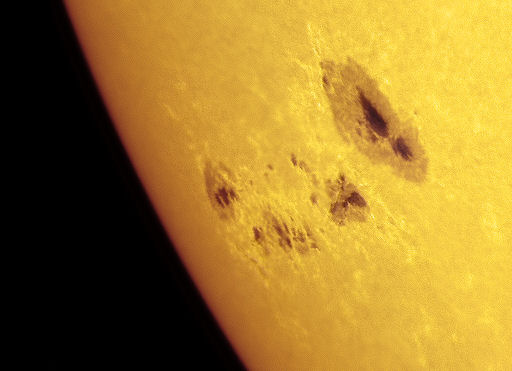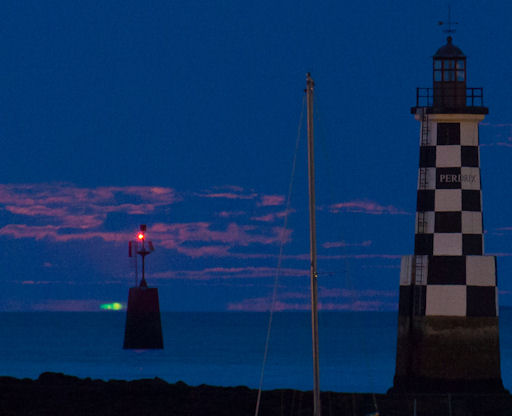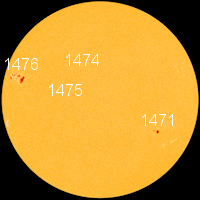~Space Weather Update~ Big Sunspot Producing M Class Flares [1]
BIG SUNSPOT: One of the largest sunspot groups in years rotated over the sun's northeastern limb this weekend. With a least four dark cores larger than Earth, AR1476 sprawls more than 100,000 km from end to end, and makes an easy target for backyard solar telescopes. Amateur astronomer Alan Friedman sends this picture of the behemoth from his backyard in Buffalo, NY:
"AR1476 is firecrackler," says Friedman.
Indeed, the active region is crackling with impulsive M-class [3] solar flares. Based on the sunspot's complex 'beta-gamma' magnetic field, NOAA forecasters estimate a 70% chance of more M-flares during the next 24 hours. There is also a 5% chance of powerful X-flares.
"This one is going to be fun as turns to face us!" predicts Friedman. He might be right. Solar flare alerts: text [4], phone [5].
more images: from John Chumack [6] of Dayton, Ohio; from Dave Gradwell [7] of Birr, Ireland; from Dave Gradwell [8] of Birr, Ireland; from Robert Arnold [9] of Isle of Skye, Scotland; from Howard Eskildsen [10] of Ocala, Florida; from Peter Desypris [11] of Athens, Greece; from Erika Rix [12] of Liberty Hill, Texas
SUPER LUNAR GREEN FLASH: Over the weekend, photographer Laurent Laveder learned an important lesson: Never take your eyes off a super moon. Laveder's back was turned when the biggest full Moon of the year rose over coast of Île Garo in Brittany, France. Fortunately, his camera was running and it caught the lunar green flash:
"I stitched together the images from my camera and made a time-lapse movie [14]," says Laveder. "The fleeting green flash was visible in only the first frame."
Other coastal effects of the super moon included high tides [15], bright reflections [16], and ducks abroad [17] after curfew. A NASA video [18] explains why this moon was so influential.
more moonshots: from Rodney Hale [19] of Houghton Conquest, Bedfordshire, UK; from Ronny Tertnes [20] of Bergen, Norway; from Ray Pacion [21] of Morristown, Arizona; from John E Cordiale [22] of Queensbury, NY; from Val Germann [23] of Columbia, Missouri; from Kamila Mazurkiewicz [24] of Janowiec, Poland; from Mitchell Krog [25] of Magaliesburg, South Africa; from Margo Werle [26] of Las Vegas, Nevada; from David Hoffmann [27] of Ashland, Oregon; from Mike Hutchinson [28] of Muncie, Indiana; from Anthony Ayiomamitis [29] of Cape Sounion, Greece; from Alberto Lao [30] of Binondo, Manila, Philippines; from Marsha Adams [31] of Sedona, Arizona

![]()
Solar wind
speed: 342.3 km/sec
density: 1.1 protons/cm3
explanation [32] | more data [33]
Updated: Today at 1656 UT
![]()
X-ray Solar Flares
6-hr max: M1 1431 UT May07
24-hr: M1 1431 UT May07
explanation [34] | more data [35]
Updated: Today at: 1600 UT
![]()
![]()
![]()
Daily Sun: 07 May 12
![]()
![]()
New sunspot 1476 is crackling with impulsive M-class [3] solar flares. Credit: SDO/HMI
![]()
![]()
![]()
Sunspot number: 104
What is the sunspot number? [37]
Updated 06 May 2012
Spotless Days
Current Stretch: 0 days
2012 total: 0 days (0%)
2011 total: 2 days (<1%)
2010 total: 51 days (14%)
2009 total: 260 days (71%)
Since 2004: 821 days
Typical Solar Min: 486 days
Updated 06 May 2012
The Radio Sun
10.7 cm flux: 117 sfu
explanation [38] | more data [39]
Updated 06 May 2012
![]()
![]()
![]()
Current Auroral Oval:
![]()
Switch to: Europe, USA, New Zealand, Antarctica
Credit: NOAA/POES
![]()
![]()
![]()
Planetary K-index
Now: Kp= 1 quiet
24-hr max: Kp= 2 quiet
explanation [41] | more data [42]
![]()
Interplanetary Mag. Field
Btotal: 6.3 nT
Bz: 5.0 nT north
explanation [43] | more data [44]
Updated: Today at 1655 UT
![]()
![]()
![]()
Coronal Holes: 07 May 12
![]()
![]()
Solar wind flowing from this coronal hole should reach Earth on May 9-10. Credit: SDO/AIA.
![]()
![]()




